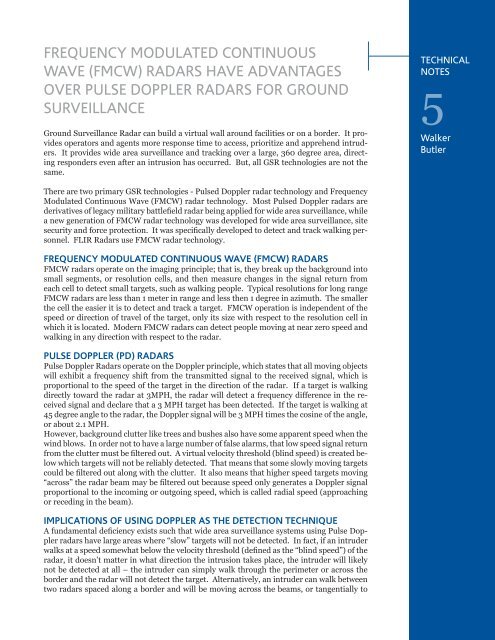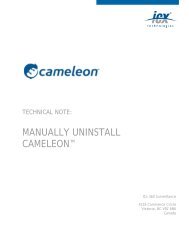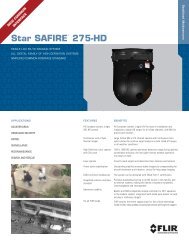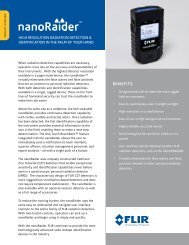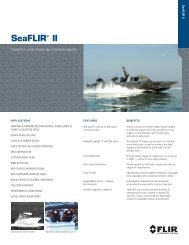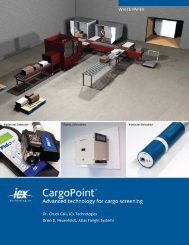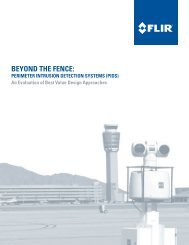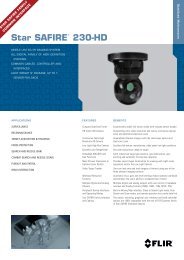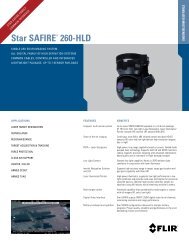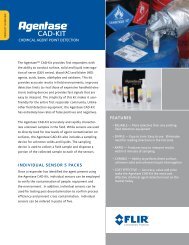FMCW Radars - FLIR.com
FMCW Radars - FLIR.com
FMCW Radars - FLIR.com
Create successful ePaper yourself
Turn your PDF publications into a flip-book with our unique Google optimized e-Paper software.
FREQUENCY MODULATED CONTINUOUSWAVE (<strong>FMCW</strong>) RADARS HAVE ADVANTAGESOVER PULSE DOPPLER RADARS FOR GROUNDSURVEILLANCEGround Surveillance Radar can build a virtual wall around facilities or on a border. It providesoperators and agents more response time to access, prioritize and apprehend intruders.It provides wide area surveillance and tracking over a large, 360 degree area, directingresponders even after an intrusion has occurred. But, all GSR technologies are not thesame.TECHNICALNOTES5WalkerButlerThere are two primary GSR technologies - Pulsed Doppler radar technology and FrequencyModulated Continuous Wave (<strong>FMCW</strong>) radar technology. Most Pulsed Doppler radars arederivatives of legacy military battlefield radar being applied for wide area surveillance, whilea new generation of <strong>FMCW</strong> radar technology was developed for wide area surveillance, sitesecurity and force protection. It was specifically developed to detect and track walking personnel.<strong>FLIR</strong> <strong>Radars</strong> use <strong>FMCW</strong> radar technology.FREQUENCY MODULATED CONTINUOUS WAVE (<strong>FMCW</strong>) RADARS<strong>FMCW</strong> radars operate on the imaging principle; that is, they break up the background intosmall segments, or resolution cells, and then measure changes in the signal return fromeach cell to detect small targets, such as walking people. Typical resolutions for long range<strong>FMCW</strong> radars are less than 1 meter in range and less then 1 degree in azimuth. The smallerthe cell the easier it is to detect and track a target. <strong>FMCW</strong> operation is independent of thespeed or direction of travel of the target, only its size with respect to the resolution cell inwhich it is located. Modern <strong>FMCW</strong> radars can detect people moving at near zero speed andwalking in any direction with respect to the radar.PULSE DOPPLER (PD) RADARSPulse Doppler <strong>Radars</strong> operate on the Doppler principle, which states that all moving objectswill exhibit a frequency shift from the transmitted signal to the received signal, which isproportional to the speed of the target in the direction of the radar. If a target is walkingdirectly toward the radar at 3MPH, the radar will detect a frequency difference in the receivedsignal and declare that a 3 MPH target has been detected. If the target is walking at45 degree angle to the radar, the Doppler signal will be 3 MPH times the cosine of the angle,or about 2.1 MPH.However, background clutter like trees and bushes also have some apparent speed when thewind blows. In order not to have a large number of false alarms, that low speed signal returnfrom the clutter must be filtered out. A virtual velocity threshold (blind speed) is created belowwhich targets will not be reliably detected. That means that some slowly moving targetscould be filtered out along with the clutter. It also means that higher speed targets moving“across” the radar beam may be filtered out because speed only generates a Doppler signalproportional to the in<strong>com</strong>ing or outgoing speed, which is called radial speed (approachingor receding in the beam).IMPLICATIONS OF USING DOPPLER AS THE DETECTION TECHNIQUEA fundamental deficiency exists such that wide area surveillance systems using Pulse Dopplerradars have large areas where “slow” targets will not be detected. In fact, if an intruderwalks at a speed somewhat below the velocity threshold (defined as the “blind speed”) of theradar, it doesn’t matter in what direction the intrusion takes place, the intruder will likelynot be detected at all – the intruder can simply walk through the perimeter or across theborder and the radar will not detect the target. Alternatively, an intruder can walk betweentwo radars spaced along a border and will be moving across the beams, or tangentially to
each radar, and therefore, can walk at a higher speed than the velocity threshold, andstill not be detected. This deficiency gives the intruders a major advantage. Those familiarwith border operations know that intruders learn to avoid areas where they areapprehended regularly. Thus, holes in coverage inherent to Pulsed Doppler radars willbe found and exploited, nullifying the very purpose of the radars. Changing the spacingor offsetting radars in latitude will somewhat change the shape of the non-detect zones,but will not eliminate the deficiency.In summary, PD radars have an inherent flaw when used in ground surveillance applications.There is a conflicting trade off between minimizing clutter returns and theminimum detection speed of the target. Most PD radars will never detect at speeds lessthan 1.5 miles per hour (a distinct probability with walkers carrying 50 pounds or moreof contraband).INTRUDER DIRECTIONTHE <strong>FMCW</strong> ADVANTAGE - SUMMARY12 kmThe STS-12000 radar has the advantage of being designed specifically for perimeter andborder surveillance using the most optimum technology for this mission: frequencymodulated continuous wave (<strong>FMCW</strong>). The benefits of <strong>FMCW</strong> over other technologiessuch as pulse Doppler (PD) are numerous:12 km• <strong>FMCW</strong> is less <strong>com</strong>plex, safer and lower cost than PD• <strong>FMCW</strong> gives low false alarm ratesAssumptionsProven in Government testing - The only radars Blind Speed to = 1.50 pass m/s stringent U.S. Air Force(2.8 mph)4 kmfalse alarm test12 kmLess likely to alarm with wind blown objects Half --- the grass detection and leaves, area has rain low doppler signatureOne <strong>FMCW</strong> installation has 31 radars netted together using only one operator• <strong>FMCW</strong> sees a higher percentage of valid targets <strong>Radars</strong> spaced 16 km apart (Typical Application)Minimum Target Speed = 2.25 mphWon’t miss slower targets or tangential ones – no holes in coverage – no onepenetrates• Smaller beamwidth for better pointing of camerasNationalBorderINTRUDER DIRECTIONINTRUDER DIRECTION12 kmNationalBorderNationalBorder12 km12 km12 kmAssumptionsBlind Speed = 1.50 m/s(2.8 mph)4 km12 kmHalf the detection area has low doppler signature<strong>Radars</strong> spaced 16 km apart (Typical Application)Minimum Target Speed = 2.25 mphAssumptionsBlind Speed = 1.50 m/s(2.8 mph)8 km16 kmDetect Probability belowUsable LevelsMore than half the detection area has low dopplersignature for slightly slower target<strong>Radars</strong> spaced 16 km apartMinimum Speed = 2.2 mph2800 Crystal Drive,Suite 330Arlington, VA 22202T +1.703.416.6666www.flir.<strong>com</strong>INTRUDER DIRECTIONNationalBorder12 km


